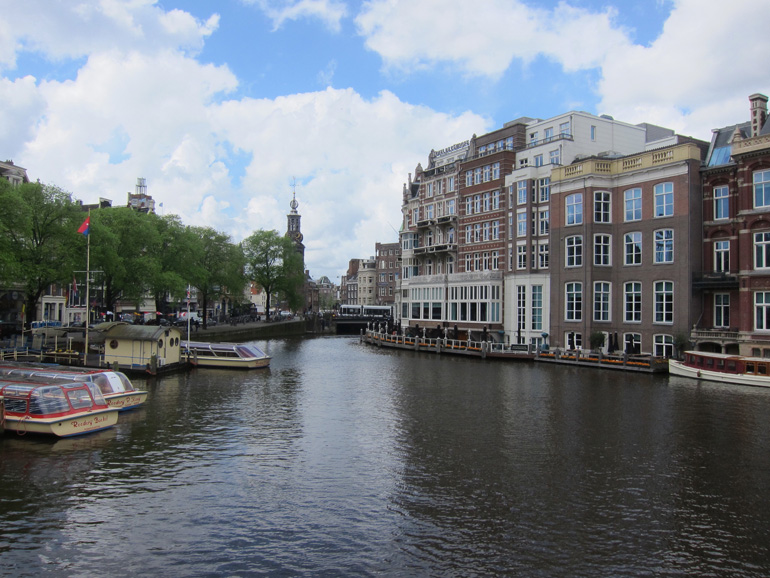Amsterdam/London:
Amsterdam Without Love
15 May 2012
Has anyone else out there ever worked on the Milton Bradley jigsaw puzzle that featured this view? That’s the Munttor (Mint Tower) in the center. Of course the puzzle provided no details about the location beyond the obvious, “Amsterdam Canal” or somesuch. I still remember the delicious surprise of turning a corner, ten years ago, and realizing that this must be the place. I was standing at the base of the Munttor at the time. If you work on a jigsaw puzzle as visually complicated as this one, the ornateness of the Hotel de l’Europe (on the right) and the angle of the tour boats (on the left) burn memories in the same part of the brain, so that I could see in a flash that if I stood on that bridge over there (the one from which the picture is taken), the puzzle scene would stand before me. As indeed it did.
I miss doing jigsaw puzzles. But who has the time, or the room? The time can’t be helped, but there’s a trick that really works when you’re doing the puzzle on a table that has to be cleared from time to time. If you lay out the pieces on a large piece of felt, you can roll the whole thing up without disturbing the pieces (very much), and then unroll the felt when you want to work on the puzzle again.
***
Itinerary: taxi to Leidesplein. Stroll up Leidestraat to Scheltema (at the Herengraacht). Onwards to the Kinderboekwinkel, just off the Spui. Lunch at Café Luxembourg. Stroll along the Binnen Amstel (see photo) and on past the Stopera to the Joodsmuseum. Then, home: stroll across the Amstel to the Rembrandtplein, then down the Reguliersgracht to Weteringschans and across the Singelgracht to Ferdinand Bolstraat. On the other side of the Heineken plant, I stopped for a black and tan at O’Donnell’s. I’d have had two, but they didn’t take plastic. In truth I was bleeding cash. I paid the taxi in cash, missing New York very much; the Kinderboekwinkel (where I bought Groene Eieren met Ham), they took plastic but only with PINs, and I’ve never used that feature of my credit card; ditto the Joodsmuseum; and then O’Donnell’s. I felt so leaky that I actually totted up my outlays when I got home, and then I subtracted the cash on hand (deceptive: the coins here really mean something), remembered tipping the hotel doorman for the taxi, and, what do you know, all but € 1.50 was accounted for. I would never do such an accounting at home.
I am going to have to read the Dutched Dr Seuss out loud a lot before I try it out on Will. (You try it, getting the rhythm right: “Niet als ik niet kan zien wat het zijn.”)
***
Walking down the Reguliersgraacht, a very quiet canal, just far enough to the east to be off the beaten track — I doubt that many people who aren’t actually neighbors tromp up and down it — it hit me: just as there are romantic people who cannot revisit a city in which they have lived in love with someone who is no longer part of their life, so I don’t much care to visit Amsterdam again until I can do so in the company of an inhabitant. There are certainly many more things to see; there always are. But the things that I want to do, I don’t want to do alone, or with other people who know the place even less well than I do. I want to have a friend who will suggest taking a tram to a movie theatre, and then maybe meeting up with (his or her) friends afterward. In short, I want to live here for a spell, but sociably. As tall orders go, it’s sky-high. But as it is, my familiarity with Amsterdam has carried me right up to a thick pane of glass that only someone who lives here can pass me through, and what I feel now, mostly, is excluded.
Or you could say that it’s payback for the gloat of possessiveness that descends upon me every time I walk into the Metropolitan Museum of Art, which is even closer to our apartment than our storage unit is. We keep our cast-offs at the storage unit, and our better things at the museum.
***
Oh! The other night, Kathleen was remembering that the only thing that she knew about the Netherlands as a little girl was the story of Hans Brinker. I knew it, too, sort of, but I’d forgotten it. What a nice idea it would be, I thought, to get an original Dutch edition! Ahem… I ought to have looked into this at home before puzzling the poor young salesclerk at the Children’s Book Shop. The echt-itude of Mary Mapes Dodge’s tale (published in 1865) is such that no one has ever seen fit to translate it into Nederlands. If I weren’t already an old duffer, I’d be mortified.

